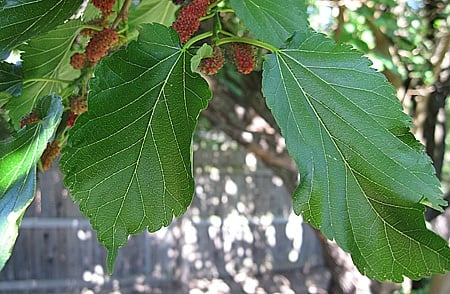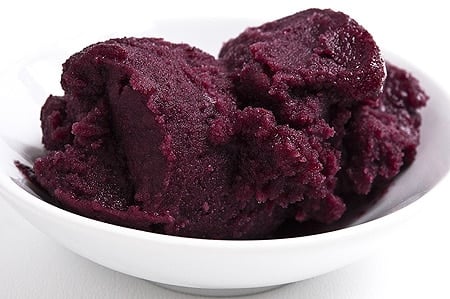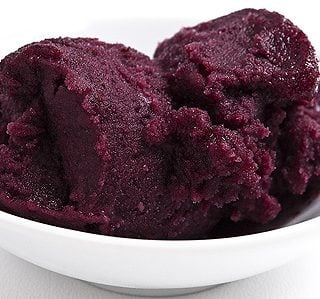As an Amazon Associate I earn from qualifying purchases.

Mulberries. Until recently, a mere mention this tree would get me going. I hate mulberry trees. They’ll conquer your yard and are nearly impossible to kill. Mulberries can send out suckers in all directions, sprouting new trees even if you chop down the main trunk. What’s worse, those that do fruit produce boring, low-acid fruit not worth eating.
Such was my belief for years. I had a mulberry problem in my yard when I lived in Fredericksburg, Virginia, and it was about that time when I got it into my head that the berries were no good. I can’t exactly remember why, other than I must have eaten some very, very ripe fruit.
One day, years back, I walked around a little park near my house. I’d been there before, and had not noticed much worth remembering; a few good oaks, but that was it. This time I heard starlings congregated in a corner of the park. They were on a tree.
It was a mulberry tree, and it was loaded with berries. What the hell, I thought. I was in mid-walk and it couldn’t hurt to pick a few for a trail snack.
Now there is this great episode of “The Simpsons” where they flash back to when Homer and the town drunk, Barney Gumble, were in high school. Barney did not drink at all then, and was set to attend Harvard University. Homer brought over some beer. Barney demurred. Finally, Homer convinces him to drink one. Barney’s eyes light up. He shouts, “Where have you been all my life?” and finishes the rest of the six-pack.
I felt like Barney. These mulberries weren’t at all insipid. No, they were tart and sweet and irresistible. And I am betting no one knows that this tree exists, tucked in a quiet corner of a little park.
Ever get one of those “I’ve been here before” moments? That’s what happened to me as I was eating those mulberries. Unlike most of my deja vu moments, however, I can remember the details of this one: When I was a boy, I used to play in the woods behind my elementary school in New Jersey, and right at the edge of those woods stood a mulberry tree. Put me there right now and I can walk you right to it, if the tree still lives.
Looking back I am sure lots of people knew this mulberry, but at the time it felt like the secret larder for me and my friends — in between “playing Army” or somesuch, we would gorge ourselves on mulberries, which I remember being ripe right as school was ending in late June.
The day after my discovery, I returned to the park with a plastic container and picked three cups of mulberries in about 10 minutes. I also saw that there would be more ripe in a few days. Mulberries don’t all ripen at once, and they ripen from a light crimson to a deep purple with reddish undertones. Mulberries are always redder than blackberries.

Mulberry trees are easy to recognize: They are the only thing in North America that looks like a “blackberry tree.” The trees have a light-colored bark and lightly serrated leaves with prominent, light-green veins.

There are several varieties of mulberry in the United States, including a native American mulberry. Colonists brought over the Chinese white mulberry centuries ago because we thought it might be a good idea to try to raise silkworms, which love these mulberries. Sadly, the worms all died. The trees did not. And by all accounts, the fruit of the white mulberry does indeed suck — no acid at all. I have never eaten one, however, so tell me if your experience is different.
(Like this recipe? I make a damn good gooseberry sorbet, too.)
As you might imagine, mulberries are super high in Vitamin C, reasonably good for iron, potassium and Vitamin K, plus they’ll give you a little fiber, too. Mulberries are also high in resveratrol, the substance present in red wine that experts say helps fight cancer. But who eats berries for the vitamins? We eat them because they taste good. Or at least I do.
My initial urge was to just eat these berries in a bowl, with cream. Berries and cream is my favorite breakfast in the world. But that wouldn’t make for much of a blog post, would it? So I thought about something to do with the berries. They seemed a little acidic — go figure, given my prejudicial thoughts about mulberries — for ice cream, so I decided on mulberry sorbet.

I often spike my sorbets with some alcohol to improve the texture, so I added some homemade elderberry liqueur to the mix. It was really good.
Mulberries have a flavor all their own. Flavors and textures are tough for me to describe, but I’ll try: Mulberries are denser and a little chewier than blackberries, which they most resemble. They are not as tart as blackberries, and my main flavor impression is a kind of high sweetness, like an alto to blackberry’s baritone. If blackberries are a cabernet sauvignon, mulberries are a pinot noir.
There are lots of other things I could do besides mulberry sorbet. I probably could do a mulberry ice cream. A mulberry sauce for venison or hare would be excellent, too. Do you have a favorite use for mulberries?
Mulberry or Blackberry Sorbet
Ingredients
- 1 cup sugar
- 1 cup water
- 5 cups mulberries or blackberries
- 2 tablespoons cassis or Port
Instructions
- If you are using mulberries, pick off all the green stems from the berries.
- Bring the sugar and water to a boil over medium heat. Let it simmer gently for 3-4 minutes. Turn off the heat and let it cool a bit.
- Meanwhile, Put the berries in a blender. Pour the syrup over them while it is warm but not hot. Buzz into a puree.
- Push the berries through a fine-meshed sieve set over a bowl using a rubber spatula or wooden spoon; this removes a lot of the seeds and stems.
- Pour the liquor into the bowl with the pureed berries and chill in the fridge for an hour or so.
- Pour into your ice cream maker and follow its directions.
Nutrition
Nutrition information is automatically calculated, so should only be used as an approximation.






Cork: They should be ready to rock by now. You will have a coupla weeks to get them – if you can beat the birds!
mulberry tarts and mulberry pies. Serve with Philadelphia style vanilla ice-cream or lime ice-cream. It’s been years since I’ve had mulberries. When we were kids they were a great treat.
I’ll have to second the cries of ‘ah childhood’. My grandmother and us kids used to pick mulberries in Nebraska, her hands were purple all summer long. Mostly she made jam and jelly and pie and we ate them. Really, really good with a flavor all their own. Oh, and we washed the cars, you can always tell when a mulberry tree is nearby…the bird poop is bright purple. Best to keep the tree at the park 😉
Wow–what a surprise, Hank! Now I’ve got to start looking, because I think I’ve seen those very pre-fruit stage in the neighborhood here on the Peninsula.
They are really hard on cars..paint I mean.
I’ll keep my eyes peeled.
Josh: Don’t see why not. Let me know how it works out…
Laura: Having never seen a jockey’s locker room between races, I have no idea what you’re talking about. But I’ll take it as a compliment just the same. 😉
Lehua: Seems there’s a theme here about pairing venison with mulberries. Maybe I oughta defrost some and give it a go!
Eli: Yeah, I picked off every goddamn stem. Forgot to mention that in the post. As for your mulberry honey cake, I included it because it looked tasty…
Gorgeous, gorgeous berries and mouthwatering sorbet. I will file this in the back of my mind for the wild blackberries that grow like crazy along the trails of the state park I live near and hike in. I will bring a bucket and come right home and make that sorbet! Thanks for the idea!
Great post. I love the idea of using limes to add some acid to the mulberries. I can’t wait until they start coming ripe in the midwest – we have at least a few more weeks to wait. When I’ve picked mulberries they have thin little stems that you have to pinch off. (My attempts to pull them out resulted in smashed berries.) But I’ve never left them on for fear they’d stay tough and ruin the dish. Did you pick off all the stems before you made the compote or just leave them in there?
Also, I was pretty surprised (in a good way, definitely) to see a link to my old blog, Eli Cooks, at the bottom of the post. I’m very flattered to be in such good company.
Oh, childhood. I grew up in south central Pennsylvania. One of the highlights of that life was eating mulberries, concord grapes, black cherries, raspberries, and pears from wild trees, bushes, and vines.
The image of “some Mexican key limes hanging around” cracks me up – your kitchen must be like the jockey’s locker room between races…
Okay, I want to make a mulberry/boysenberry pie. You think those two’ll go together?
Hank-
You are correct, mulberries most certainly are a major berry in the middle east. In Lebanon, in my little town in the North the trees are everywhere and are very highly prized and loved. I much prefer them over the super tart blackberries. Maybe that’s because I loved them as a kid picked from the neighbors’ trees or from when my grandmother bought them from local travelling farmers/grocers…who knows. It’s a shame that I can almost never find them here unless I “forage” for them.
You are also right about the white mulberries, I never liked them. They basically had one flavor note, “mildly sweet”. They have no aroma, no astringency and not a hint of acid. Some in Lebanon prized those qualities though..go figure. I do remember town people using the leaves of the mullberry (known as “toot” BTW) to feed their silk worms.
Coincidentally, I just had a great meal from a very creative chef that used foraged mulberry. Chef Justin of Market Fresh Bistro in Makawao, Maui (Hawaii) created a mulberry-ginger compote to complement a medium-rare cut of venison. The compote set the venison off extremely well (I wish I had the recipe, but I have a feeling he would share it if you ask!). The great thing about Market Fresh Bistro is that they create new menus for every meal based on the local resources available (something important when you’re trying to promote sustainability thousands of miles from the nearest continent). (And you may like the fact that the venison was harvested from the local axis deer that are running rampant and destroying the forests in the islands, where they have no natural predators). (By the way, I don’t work at Market Fresh, but love what they’re trying to do here in Maui, as a newbie sustainable farmer)
Jam, I like the seeds and prefer it over a jelly
Compote – served with a seared venison loin….idea came from a caribou loin w/ partridgeberry ‘sauce’ I had in St. John’s at Bacalao (https://bacalaocuisine.ca/) …. best meal I’ve ever had in Canada.
Fresh over ice cream
Frozen to be used later for pie and cobbler
Josh: I don’t like a lot of stuff in my fruit compotes. Maybe a hint of allspice or clove, but that’s about it.
Karen: Thanks for the kind words! Yeah, I’ll skip the dress, but a shirt that color’d be cool.
Kate: Yes, there are all sorts of mulberry varieties in the world, and some are big bushes. They are apparently a major berry in the Middle East.
Carolina: Pail? What did you do with the mulberries?
Pale?? I need more coffee….
I’m usually out of town this time of year, so this is the first time I can take advantage of the two mulberry trees that are on the island I work at. Beating the birds to the berries has been challenging. Mockingbirds and grackles are so possessive. Instead of picking them, I brought a tarp and pale into work. Climbed the tree (only a few feet up) and shook. Bucket-o-berries ready for processing.
We have a few mulberries around us. The litter property lines in this area, for some reason. Few of them are at all productive and none highly productive. My husband did gather some a while back and ended up making a jam that was more of a cheese – in the sense that membrillo is quince “cheese.” It was more slice-able than spreadable, but good nonetheless.
Incidentally, I’ve wondered in recent years why the nursery rhyme speaks of “the mulberry bush.” If mulberries were bushes, I’d keep one, even in our very modest backyard. I only know them as massive trees that dominate a landscape, which we don’t have room for. Any idea whether there are mulberry varieties that remain bushes?
You say that flavors and textures are tough for you to describe, and then you come up with this?? “… my main flavor impression is a kind of high sweetness, like an alto to blackberry’s baritone.”
As usual, I have a difficult time with what I love more – your food or your writing.
I’d like to have a dress the color of that sorbet!
I think “tame” was the most apt description. I’ve been picking a couple here and there on my way to and from work each day. They’ve gotten better, and what I like about them is that, if not perfectly ripe, their tartness doesn’t implode your face. They are tame.
I think they might make a good compote with a couple of spices, but I don’t want to overload it. What might you recommend?